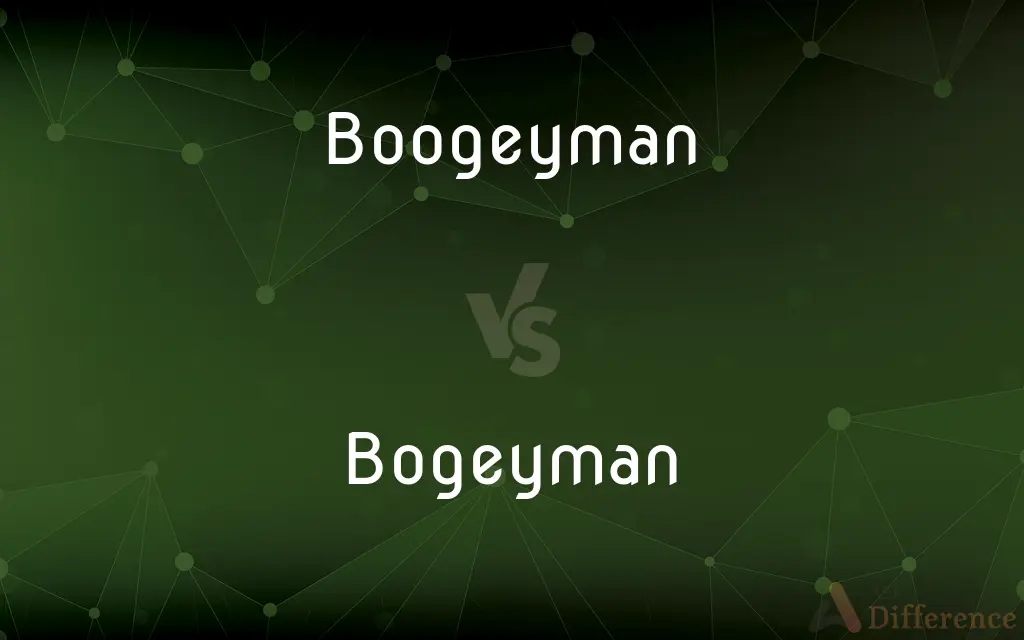Boogeyman vs. Bogeyman — What's the Difference?
By Fiza Rafique & Maham Liaqat — Updated on April 3, 2024
Boogeyman and bogeyman are different spellings of the same mythical creature used to frighten children into good behavior.

Difference Between Boogeyman and Bogeyman
Table of Contents
ADVERTISEMENT
Key Differences
The terms "boogeyman" and "bogeyman" refer to a mythical, menacing figure often invoked by adults to encourage children's obedience or good behavior by inciting fear of this imaginary creature. The difference between the two lies primarily in the spelling, which varies by region and cultural influence, rather than in any distinct characteristics or origins of the creature itself.
Both versions of the creature are depicted as lurking in dark places, such as closets or under the bed, waiting to scare or punish naughty children. This universality across cultures highlights the boogeyman's role in folklore as a form of behavioral control, exploiting children's fear of the unknown.
Despite the slight variance in spelling, the essence and purpose of the boogeyman/bogeyman remain consistent: to embody the universal fears and anxieties present in childhood. The creature is often shapeless or can assume various forms, which allows it to adapt to the specific fears of individuals or societies.
The origins of the boogeyman are difficult to trace to a single source, as similar figures exist in many cultures worldwide, each with its unique name and characteristics but serving a similar purpose. This suggests that the concept of a frightening figure used for discipline is a common human social tool.
The choice between "boogeyman" and "bogeyman" often depends on regional language preferences, with "bogeyman" being more common in British English and "boogeyman" in American English. This variation in spelling does not affect the mythical creature's role or the tales associated with it but merely reflects linguistic differences.
ADVERTISEMENT
Comparison Chart
Spelling Variations
Preferred in American English
Preferred in British English
Origin
Mythical creature used to scare children
Same as Boogeyman
Purpose
To encourage good behavior in children
Same as Boogeyman
Depiction
Lurks in dark places to scare children
Same as Boogeyman
Forms
Can assume various shapes based on fears
Same as Boogeyman
Compare with Definitions
Boogeyman
A mythical figure used to frighten children into behaving.
Parents sometimes tell stories of the boogeyman to prevent their kids from misbehaving.
Bogeyman
Another spelling for a creature used to incite fear for discipline.
The bogeyman story varies from one culture to another but always serves to teach a lesson.
Boogeyman
A universal symbol of childhood fears.
The concept of the boogeyman exists in various cultures, albeit under different names.
Bogeyman
Adapts to the fears of the listener.
For some children, the bogeyman is more of a sound or a whisper in the night.
Boogeyman
Often depicted as lurking in the dark.
The boogeyman is said to hide under beds or in closets.
Bogeyman
A figure in stories told by parents and elders.
The bogeyman has been a feature of bedtime stories for generations.
Boogeyman
Associated with tales and warnings.
Folk tales often include the boogeyman as a cautionary figure.
Bogeyman
Reflects universal anxieties during childhood.
Despite cultural differences, the bogeyman symbolizes a common childhood experience of fear and caution.
Boogeyman
Can take on various forms to embody children's fears.
To some, the boogeyman might appear as a shadowy figure.
Bogeyman
Known for hiding in specific places to surprise children.
Stories depict the bogeyman as waiting silently in the dark for the right moment.
Boogeyman
A terrifying specter; a hobgoblin.
Bogeyman
The Bogeyman (; also spelled boogeyman, bogyman, bogieman, boogie monster, boogie man, or boogie woogie) is a type of mythic creature used by adults to frighten children into good behavior. Bogeymen have no specific appearance and conceptions vary drastically by household and culture, but they are most commonly depicted as masculine or androgynous monsters that punish children for misbehavior.
Boogeyman
An exaggerated or nonexistent threat used to intimidate others
“Welcome to the era of the ‘bot' as political boogeyman” (Washington Post).
Bogeyman
Variant of boogeyman.
Boogeyman
Alternative form of bogeyman
Bogeyman
A menacing, ghost-like monster in children's stories.
Boogeyman
Something frightful, as a specter; anything imaginary that causes needless fright; something used to excite needless fear; also, something really dangerous, or an imaginary monster, used to frighten children, etc.
Bogeyman
(by extension) Any make-believe threat, especially one used to intimidate or distract.
Boogeyman
An imaginary monster used to frighten children
Bogeyman
A goblin; a bugbear; a bogey{1}. This is the form used by parents to frighten children; as, if you don't eat your vegetables, the bogeyman will get you.
Bogeyman
An imaginary monster used to frighten children
Common Curiosities
What is the purpose of the boogeyman in folklore?
The boogeyman serves as a cautionary figure to promote good behavior among children by leveraging their fear of the unknown.
What is the most common setting for boogeyman stories?
Boogeyman stories often involve dark, enclosed spaces like closets or under the bed, playing on common childhood fears of the dark.
How does the concept of the boogeyman affect children?
While intended to promote good behavior, the boogeyman concept can also stimulate imagination and address the universal experience of fear during childhood.
Are boogeyman and bogeyman the same thing?
Yes, they are different spellings of the same mythical figure used to invoke fear for behavioral control in children.
Can the boogeyman take on different forms?
Yes, the boogeyman is often described as shape-shifting or taking on various forms to embody the specific fears of individuals or cultures.
Is the boogeyman based on a real creature?
No, the boogeyman is a mythical creature with origins in folklore, serving as a symbolic figure rather than being based on any real entity.
Why are there two spellings for the boogeyman?
The variations in spelling reflect regional language differences, with "boogeyman" being more common in American English and "bogeyman" in British English.
How do parents typically use the boogeyman?
Parents might reference the boogeyman in stories or warnings to deter misbehavior or encourage obedience in children.
Do all cultures have a version of the boogeyman?
While the name and specific characteristics may vary, many cultures have a similar figure used to embody fear and encourage discipline.
Has the perception of the boogeyman changed over time?
Yes, while the basic concept remains, contemporary media and literature have expanded on the boogeyman's characteristics, sometimes even portraying it in a less frightening or more nuanced light.
Share Your Discovery

Previous Comparison
Hero vs. Legend
Next Comparison
Deliver vs. ProvideAuthor Spotlight
Written by
Fiza RafiqueFiza Rafique is a skilled content writer at AskDifference.com, where she meticulously refines and enhances written pieces. Drawing from her vast editorial expertise, Fiza ensures clarity, accuracy, and precision in every article. Passionate about language, she continually seeks to elevate the quality of content for readers worldwide.
Co-written by
Maham Liaqat















































